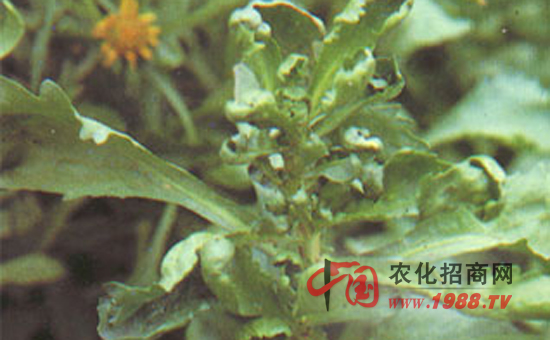What harm does chrysanthemum virus disease have?
Virus disease is an important disease in chrysanthemum cultivation, which is widely distributed. Chrysanthemum virus diseases occur all over China, including chrysanthemum infertility virus, chrysanthemum mosaic disease, chrysanthemum malformation disease and so on.

Chrysanthemum virus disease is also known as mosaic disease. The disease occurred in the whole plant and the damage was serious. Common symptoms include: yellow heart leaves or mosaic leaves, veins green, leaves withered from bottom to top; abnormal leaves of diseased plants, with gray-green slightly raised linear stripes on the heart leaves, irregular arrangement, and gradual disappearance of symptoms in the later stage; yellow irregular patches appear on the leaves with obvious edge boundaries; leaves are dark green, small and thick, with purplish red on the edge or back, and the diseased plants are prone to downy mildew and brown spot. Among them, CVB caused light mosaic or asymptomatic, and could form heavy mosaic and necrotic spots on susceptible varieties. ToAV often shows that the plant is small, the flower color is abnormal, and sometimes cause leaf deformation or ear process. ToSWV caused white circular linear markings on the leaves. In addition, when several toxins are co-infected, the symptoms are more complicated.
What is chrysanthemum virus disease?
Chrysanthemum virus disease is very harmful, which often leads to serious damage to the growth of chrysanthemum, so what are the performance characteristics after the emergence of chrysanthemum virus disease?
Chrysanthemum virus disease in chrysanthemum showed light mosaic or no manifestation, and susceptible species could form heavy mosaic and necrotic spots (CVB). ToAV can be reflected in abnormal patterns, low plants, and sometimes deform leaves or form ear processes. On the other hand, white circular linear markings appeared on the leaves of ToSWV. Because the species, growth period and culture environment of chrysanthemum are different, as well as the compound infection of virus formation, it is very messy.
- Prev

Pest control of Parthenocissus parthenocissus
The diseases of Parthenocissus are powdery mildew, leaf spot and anthracnose. Common aphid harm. Because of its strong resistance, Parthenocissus has less diseases and insect pests, but it also occurs from time to time, especially in the plum rain season, due to high temperature and high humidity, powdery mildew, leaf spot and anthracnose are easy to occur.
- Next

What are the manifestations of violet downy mildew
Downy mildew is a major disease in violets. The disease harms the leaves, shoots and flowers of the host. At the beginning, there are light green spots on the leaf surface, and then become yellow spots. There is a white downy mildew layer on the back of the corresponding leaves. Tender shoots and flower hands are often dwarfed or deformed after infection. When the damage is serious, the leaves droop and the whole plant dies.
Related
- Fuxing push coffee new agricultural production and marketing class: lack of small-scale processing plants
- Jujube rice field leisure farm deep ploughing Yilan for five years to create a space for organic food and play
- Nongyu Farm-A trial of organic papaya for brave women with advanced technology
- Four points for attention in the prevention and control of diseases and insect pests of edible fungi
- How to add nutrient solution to Edible Fungi
- Is there any good way to control edible fungus mites?
- Open Inoculation Technology of Edible Fungi
- Is there any clever way to use fertilizer for edible fungus in winter?
- What agents are used to kill the pathogens of edible fungi in the mushroom shed?
- Rapid drying of Edible Fungi

